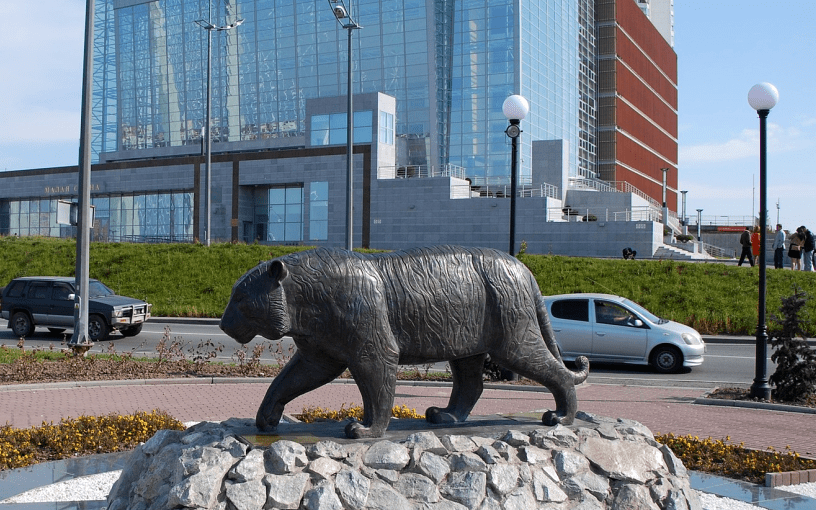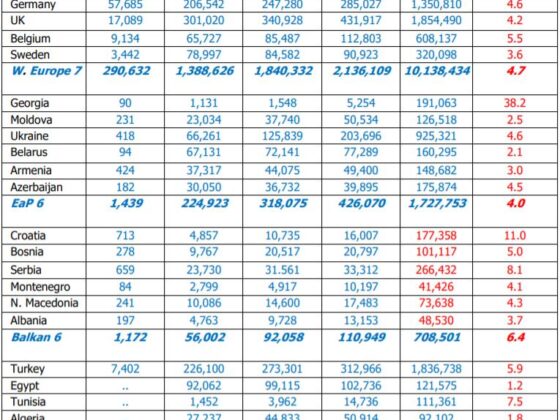Policy Memo: 682
Publication Date: 12-2020
Author(s): Ekaterina Koldunova
(PONARS Eurasia Policy Memo) Since the turn of the century, the idea of the Russian Far Eastern regions’ economic rise through cooperation with East Asian countries has been a persistent element of Russian political leadership rhetoric. Until very recently, however, this rhetoric did not fully correspond to Russia’s domestic and foreign policy actions. Russia’s economic cooperation with East Asian countries (except China) remained relatively low as compared to its economic relations with Europe. In the mid-2000s, domestic and international concerns provoked Moscow to initiate new, state-administered programs for the Far East. Domestic concerns included rising economic and demographic asymmetry between the European and Asian parts of Russia and between the Asian parts of Russia and nearby regions of China. International concerns involved the widening economic gap between Russia and China and deteriorating relations with the West because of the Ukrainian crisis in 2014.
Russian efforts to develop the Far East as well as Russia’s “turn to Asia”—both proclaimed just before 2014—initially seemed to be discursive and most probably unexceptional. However, as argued here, a new wave of Russian reforms sped up economic development in that region. This has led to an emerging, specific form of regionalism, which may transform center-periphery relations in Russia’s model of federalism. This dynamic, though, is very selective, largely economic in character, applied to only one particular area of the country, and still state- rather than region-driven. Within this dynamic, so far, intra-bureaucratic battles have consumed needless energy, and the region’s chronically decreasing population numbers pose a threat to any development plans.
The Role of the Far East
More scholarship is needed on the issue of Far Eastern “underdevelopment,” looking through the prism of both Russian federalism and the way Russia’s Asian policy has been transforming the region. Knowledge gaps include the role of the Far East in Russia’s system of center-periphery relations and the logic behind bureaucratic struggles over authority to develop the region—all against the background of deep transformations on the international scene.
Moscow’s relations with its Asian regions and perceptions of “East” and “West” among the Russian political elite have become a focus of several philosophical and historical studies. There have also been numerous studies on center-periphery Russian relations with a specific look at the case of the Far East. But these have mainly emphasized the region’s economic, demographic, or social problems that have resulted in specific electoral behaviors and in distrust in the government’s efforts to upgrade development in that area. An important stream of analytical writing concerning the Far East has been about using appropriate state instruments to develop the region internally and its role in Russian foreign policy in Asia.
Traditionally, the Far East was a military, political and economic frontier of Russia in Asia. Its main maritime city, Vladivostok, became a free trading port with a short history of successful economic development at the turn of the 19th and 20th centuries. However, later on, in the Soviet period, it functioned to a greater extent as a military post and not as an economic connection with East Asia. The Far East was then understood as a macro-region devised for economic planning. After the collapse of the Soviet Union, it retained its administrative borders uniting nine administrative units: Amur oblast, Jewish Autonomous oblast, Kamchatka krai, Magadan oblast, Primorsky krai, Sakha Republic, Sakhalin oblast, Khabarovsk krai, and Chukotka autonomous okrug.
Historically, the Far East was the home of several waves of separatism, which, however, did not encompass its whole territory. Thus, for example, the so-called Far Eastern Republic (in existence from 1920 to 1922) included Amur, Transbaikalia, Kamchatka, Primorye, and Sakhalin. In the 1990s, separatist tendencies spread mainly among the maritime coastal cities, which started to become more interconnected economically with neighboring China and Japan (mainly through the “shadow economy”). In short, however, there have been no historical reasons for political or economic regionalism that could have united today’s Far East administrative entities. Since then, Russia’s economic cooperation with East Asian countries (except China) has remained relatively low as compared to Russia’s relations with Europe.
The Far East in Russia’s Center-Periphery Relations
Center-periphery relations in Russian federalism have fluctuated from loose connectivity under President Boris Yeltsin to high centralization under President Vladimir Putin. However, existing typologies have not seriously considered the ways that the Far East may serve Russia’s goal of economic development. At the same time, the political leadership has been advocating the idea of a proactive Russian stance toward East Asia. Until 2012-14, Russia’s foreign policy actions toward East Asia, however, did not follow official rhetoric: the Russian political and economic elite has remained largely Europe-oriented, and Russia has lacked comprehensive economic interdependence with East Asia. Throughout the second decade of this century, only China dominated the Russian external trade landscape, with its share of the overall Russian trade growing from 10.5 percent in 2012 to 16.6 percent in 2019. Japan, South Korea, and ASEAN member states significantly lagged behind.
Domestically, Russia has faced the increasingly pressing problem of developing its Siberian and Far Eastern regions. Since the early 1990s, the Far East has faced economic stagnation and demographic decline that exceeds average levels of depopulation in Russia sixfold. During the two decades from 1989 to 2010, it lost 20 percent of its population (the same numbers for Russia, in general, constituted 3.5 percent).
Internationally, one of the outcomes of the deterioration of relations with the West has been Russia’s stronger relations with China, as exemplified by the Russo-Chinese gas deals struck in 2014 and the agreement to connect the Chinese Belt and Road Initiative with the Russia-led Eurasian integration project in 2015. The implications and durability of these stronger relations, however, haveraised new questions. Some consider the dynamics of Sino-Russian relations as a sign of a new political (and probably military) alliance in the making, while others question the symmetric nature of these relations taking into account China’s stronger economic stance vis-à-vis Russia. The COVID-19 pandemic just added more complexity to these relations: while Russian and Chinese official discourse stressed the two countries’ unity in the face of the common threat, the coordination in tackling this threat in the areas of Siberia and the Far East neighboring to China has lagged behind.
Federal Efforts to Cope with the Far East
The 1996 “Federal Program of the Far Eastern and Transbaikalia Regions’ Economic and Social Development“ has remained mainly on paper. According to some non-official estimates, by the end of the first decade of this century, the program was only 25 percent implemented. With East Asia’s economic rise, the asymmetry between Russia’s most peripheral region and Russia’s Asian neighbors has been rapidly expanding. Far Eastern socio-economic problems became particularly visible when the Chinese North-Western regions, which used to suffer from underdevelopment, started to witness positive economic dynamics.
In the 1990s, integration between the Far East and East Asia was seen in a distorted way. “Integration” meant shadow economy deals—often involving Russian timber and other products, as well as migration flows between China and Russia. Overall, the ongoing failure of the Russian government to resolve the socio-economic problems of its Asian regions has prompted some analysts to conclude that Russia cannot sustain the burden of its vast territory and needs to “shrink.”
The decision to transform Vladivostok into a venue for the 2012 APEC Summit became a turning point in Russia’s Far East policy, heralding a more attentive approach by the Russian government to the region. At the same time, preparations for the summit revealed serious intra-elite divides concerning ways of developing the broader Siberian region. As the limited (at best) success of the federal program demonstrated, some Russian analysts argued, the traditional bureaucratic way was not appropriate for upgrading economic and social conditions in the Far East.
Just two years before the APEC Summit, then-Prime Minister Putin charged then-Minister of Emergency Situations Sergei Shoigu to develop a draft project on the so-called “Eastern Corporation,” an autonomous state agency that could have focused specifically on the development of Eastern Siberia and the Far East. This agency, if created, would have had expanded authority, including in the financial sphere. As expected, the blueprint of the corporation met resistance from the financial bureaucracy. Minister of Finance Anton Siluanov instead proposed to create a federal agency, a structure of a much lower status and limited mandate.
In 2012, a consensus decision was to establish the new Federal Ministry for the Development of the Far East. In 2013, a new round of intra-bureaucracy battles resulted in a government decision to transfer some responsibilities from the Ministry of Regional Development, the Ministry of Economic Development, and the Ministry of Finance to this new entity.
In addition to the debate on what kind of agency should manage the development of the Far East, the government had also to choose between two diverging concepts of development. Ex-Minister of the Development of the Far East Viktor Ishayev personified the first one, while Vice-Premier Igor Shuvalov, who was responsible for the 2012 APEC Summit, personified the second. The former advocated a standard scheme of expanded state budget-financed investment in the social sphere and infrastructure, while the latter proposed to focus on certain clusters that could attract private investment and generate economic growth. In 2013, Putin replaced Ishayev with Alexander Galushka as the new minister for Far Eastern development and nominated Yuri Trutnev as vice-premier and the president’s representative in the Far East, thereby showing that the second concept had won the competition.
Trutnev and Galushka proposed three main goals. The first was to build an export-oriented economy, primarily in the natural resource sector. The second was to create extra-favorable conditions for business, comparable and even surpassing those existing in the neighboring East Asian economies. The final goal was to develop in the Far East more sophisticated industries such as the space industry (in the Amur region), aircraft building industry (Khabarovsk region), the shipbuilding and assembly industries (Vladivostok environs), and natural resource exploration. As the instrument of achieving these goals, Trutnev and Galushka created so-called “territories of advanced development,” special territorial clusters that have favorable conditions for business and investments.
The idea of a “Free Port Vladivostok” represents yet another example of an intra-bureaucratic struggle. To create better conditions for business connections, the Ministry of Far Eastern Development announced a visa-free regime for Vladivostok. This should have come into effect in 2015, by the first Eastern Economic Forum, a large-scale business-oriented international event launched to sustain the dynamics of reforms in the Far East. However, the enactment of the regime was postponed until 2017 due to a debate between various federal agencies concerning the scope and procedure of opening up Vladivostok and the neighboring area for international visitors. As a result, the number of countries eligible for a free electronic visa to enter Vladivostok was considerably reduced—out of all East Asian countries, the special regime started to function only for Brunei, China, Japan, North Korea,[1] and Singapore.
A combination of economic, social, and political indicators signaled that the centralized, government-driven regionalism did not fully correspond to the interests of the inhabitants. Despite official claims of a strong economic breakthrough, in fact, many declared projects did not properly function and were surrounded by bureaucratic difficulties. By 2019, only 7 out of 31 international projects in the “advanced development territories” started to operate. The infrastructure development index for the Far East remained lower than the Russian average (3.02 compared to 3.24) and almost three times lower than Moscow’s (8.2). Demographically, the population of the Far East has continued to decrease over this past decade. Only 1 percent of the overall Russian population considered moving to the Far East for permanent residence even with the favorable conditions created by the federal programs.
The gubernatorial elections in Primorsky Krai in 2018 highlighted the broader problem when repeated elections were necessary to secure the victory of Oleg Kozhemiako, the central government-supported candidate. The local population’s discontent with federal management of regional affairs became visible in the prolonged mass protests against the arrest of now ex-governor of Khabarovsk krai Sergei Furgal. The protests started in August 2020 and had not fully stopped even by December. In this case, the substance of the charge against Furgal became secondary vis-à-vis the local populations’ aspiration to make their own decision concerning the gubernatorial nominee via elections.
Conclusion
Over the last ten years, Russia’s political elite has demonstrated a will to solve the problem of Far Eastern underdevelopment. It created new institutions and drafted new financial and legal frameworks that differ from those of the rest of the country. However, the period mainly saw the institutional development of a new ministry, which was busy with intra-bureaucratic battles and conceptual discussions rather than practical measures. At the same time, the new stage of state policy toward the Far East represented a qualitatively different approach compared to previous periods. First, it took into account the inevitability of opening up internationally. Second, it created new legal, financial, and economic instruments to this end. That said, although transformations have been economically oriented, they have been state-driven and bureaucratic rather than region-led.
Ekaterina Koldunova is Associate Professor in the Asian and African Studies Department and Senior Expert in the ASEAN Centre at the Moscow State Institute of International Relations (MGIMO).
[PDF][1] Russia has had a visa-free regime with South Korea since 2014. On April 13, 2020 South Korea temporarily suspended the visa-free agreement with Russia due to the pandemic.
Homepage image credit.











